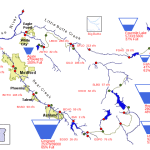by Dean Silver
Water is life. Most of western United States, including Ashland, is in the midst of what is inarguably a significant period of drought. The old “normal” is no longer normal. Climate change is wreaking havoc with historical patterns of rain and snowfall. Here in Ashland, we see evidence of it year round.
As we drive into town, we see message boards imploring us to conserve water. And as a community, we have answered the call. Household water use is down in Ashland over the past decade. Yet not everyone seems to have gotten the message. One of the largest users of potable/treated/culinary/drinking water in the city is the Ashland Parks and Recreation Department.
APR utilizes Talent Irrigation District (untreated ditch) water when possible. TID water is far less costly than treated potable water. Unfortunately, the availability of TID water was greatly reduced in 2021 due to the drought and low water levels in the reservoirs.
Faced with the unavailability of the TID water during most of 2021, APR management decided to utilize our treated/potable/household/culinary/drinking water for irrigation.
Busting the Budget
Note to readers: if reading about numbers isn’t your preference, skip down to the graphs. They are self-explanatory.
For budgeting purposes, APR assigns golf course expenses to one account, and all other park properties (excluding recreation facilities and programs, and forestry) to another, known as “Operations”.
For FY 2021, APR budgeted $215,000 for water use under the Operations account, and $17,500 under the Golf division. APR utilizes TID water when possible. For the 2021 water year, the TID annual charges were $2,780.40 for Operations, and $4,795.40 for the Golf division.
In FY 2020, spending for water exceeded the budgeted amounts, so the budget for FY 2021, the second year of the biennial budget, was revised (reduced). The revised budget for water was $199,673.08 for Operations, and $8,752.02 for Golf. The total revised budget for water was $208,425.10.
Total actual spending by APR on water for FY 2021 was $338,143.56. That breaks down as $289,097.54 for Operations and $49,046.02 for Golf. That is 145% of budget for Operations and 560% of budget for Golf, overall 162% of the total budget for water.
For FY 2022, Operations budgeted $277,200 for water, and Golf budgeted $29,000, resulting in a total of $306,200. That is a budgeted 29% increase for Operations and a 66% increase for Golf, overall a 32% increase. So despite the drought, and probably because of it, APR budgeted to increase the use of city water for irrigation.
50% of FY 2022 had elapsed as of December 31, 2021. As of that date, Operations had expended $209,087.69 for water, and Golf had expended $72,670.80 for water. That is 75% of the budgeted amount for Operations, and 251% of the budget for Golf for the entire fiscal year.
As illustrated in the graphs, APR water expenditures exceeded its budget significantly for FY 2021. For the first half of FY 2022, Golf has significantly exceeded the budget for the entire fiscal year, while Operations has significantly exceeded half of its budget. Of course, APR’s expenditures for water may not continue at the same pace for the second half of the fiscal year, but if they do, Operations will have exceeded its annual budget by 51%, and Golf will have expended five times (5x) its budget.
Other Relevant Considerations
Due to the nature of our city’s water infrastructure, it is not always possible to irrigate parks with ditch water. In those cases, potable water is the only source for irrigation.
Of course, not all APR water use is for irrigation. It should be noted that the Senior Center and Recreation Programs do not budget any amount for water, and thus their non-irrigation uses are included in Operations.
The golf course water use fell precipitously in November and December, 2021, down to $734.21 and $466.95 respectively. September, October, and December were uncharacteristically wet months. That provides an indication of a reasonable baseline for golf course water use when city water is not utilized for irrigation. Likewise, Operations water use was greatly reduced in November and December. The table below shows the monthly expenditures. It should be noted that the recorded expenses lag the uses by about a month. Thus, the August bill would likely reflect usage in July.
| Jun-21 | Jul-21 | Aug-21 | Sep-21 | Oct-21 | Nov-21 | Dec-21 | |
| golf course | 34,550.35 | 14,197.79 | 15,061.99 | 28,738.55 | 13,471.31 | 734.21 | 466.95 |
| operations | 14,198.73 | 49,765.00 | 72,506.91 | 52,212.24 | 21,828.22 | 6,627.52 | 6,147.80 |
| total | 48,749.08 | 63,962.79 | 87,568.90 | 80,950.79 | 35,299.53 | 7,361.73 | 6,614.75 |
Graphs




Conclusion
This data raises a number of important questions. Is the Parks and Rec Department using our most precious natural resource, water, wisely? Does the community think that use of this much potable/treated/culinary/drinking water for irrigation an appropriate use of that water? Are the Parks and Rec Commissioners even aware that the department management has made the decision to use this water in this manner? How does this correspond to our values as a community?
If the drought continues, how will APR deal with irrigation? The city has been encouraging homeowners to replace their lawns with less water intensive landscaping for years. Will we be able to maintain irrigated lawns in parks as we have in the past? This cannot be a decision of APR management, the Commission must provide direction. Should the residents via their representatives on the City Council make the final determination?
Should the golf course have the same priority for irrigation as the community parks? The golf course is comprised of 72 acres, while all of the developed community parks (excluding Lithia Park, itself 100 acres, only a portion of which is irrigated) total only about 80 acres.
The management of the Ashland Parks and Recreation has complained strenuously regarding its current funding, and its ability to maintain the parks given the funds it has been allocated. Does this data indicate that they are utilizing that funding efficiently and effectively to its best use?
Does the city need to revamp its water infrastructure to utilize more ditch water (if it will even be available in the future), or to investigate gray water systems and water reuse systems?
One thing is certain: we cannot afford to continue to spend this much money and water irrigating golf courses and lawns. It is not sustainable.
Citizens and taxpayers can express their opinions and ask questions by emailing the Parks and Recreation Commissioners and department Director Michael Black with one email address: parks_commissioners@ashland.or.us . You can also contact Director Black individually at michael.black@ashland.or.us or by phone at 541-816-5459.





